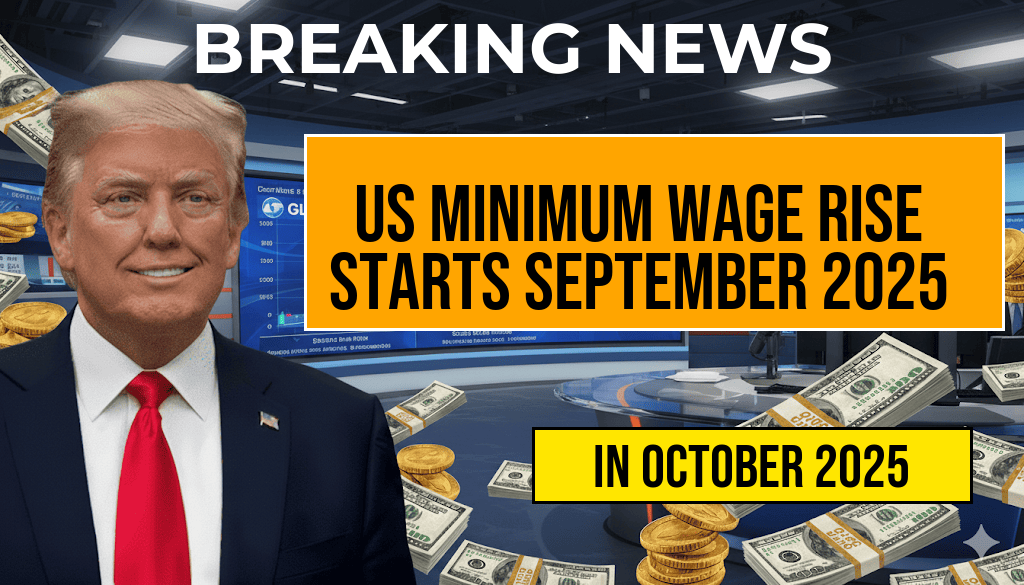The United States is set to implement a nationwide increase in the federal minimum wage starting September 30, 2025, marking a significant shift in the country’s labor standards. This adjustment responds to ongoing debates about living wages and economic equity, with policymakers aiming to improve income levels for millions of low-wage workers. The new rates will vary across states and municipalities, reflecting local economic conditions and legislative decisions. Employers and employees alike are preparing for the change, which could influence wage structures across multiple sectors. This article provides a comprehensive overview of the upcoming minimum wage adjustments, detailing the new hourly rates by jurisdiction, the rationale behind the increase, and potential impacts on the labor market.
Background of the Minimum Wage Increase
The federal minimum wage has remained at $7.25 per hour since 2009, but recent legislative efforts and economic analyses have prompted calls for raising it. The upcoming increase is part of a broader legislative package aimed at addressing income inequality and supporting workers in an evolving economic landscape. The decision aligns with recommendations from economic studies suggesting that a higher minimum wage can boost consumer spending and reduce poverty, though critics argue it might lead to increased automation and reduced hiring in certain sectors [source: Wikipedia’s Minimum wage in the United States].
Details of the September 2025 Adjustment
The new federal minimum wage will be implemented gradually over several years, with the initial increase taking effect on September 30, 2025. The specific rates will depend on regional legislation, with some states and cities opting for higher thresholds based on local economic conditions. While the federal baseline will rise, individual states with their own minimum wage laws may set rates above the federal level, leading to a patchwork of wages across the country.
New Hourly Rates by Jurisdiction
The table below summarizes the forthcoming minimum wages across various states and key cities, highlighting the diversity in wage standards nationwide.
| Location | Hourly Rate |
|---|---|
| Federal (baseline) | $10.50 |
| California | $16.50 |
| New York (Statewide) | $15.75 |
| Texas | $10.50 |
| Florida | $12.50 |
| Illinois | $14.00 |
| Massachusetts | $15.00 |
| Washington | $15.74 |
| Oregon | $15.45 |
| Colorado | $14.77 |
| New Jersey | $14.50 |
| Alabama | $8.20 (state minimum, federal applies where higher) |
| Louisiana | $7.25 (federal minimum) |
States with No Minimum Wage Legislation
- Georgia
- Wyoming
- Idaho
In these states, the federal minimum wage remains applicable unless local ordinances specify otherwise.
Factors Influencing State and Local Wage Policies
States with higher living costs tend to set their minimum wages above the federal baseline, aiming to provide better support for their residents. For example, California and Washington are among the highest, reflecting their urban density and housing expenses. Conversely, states like Alabama and Louisiana maintain federal minimums to mitigate potential economic burdens on small businesses. Local governments within states also have the authority to enact wage ordinances, creating a complex landscape of wage standards across the country.
Implications for Employers and Workers
Businesses will need to adjust payroll systems to comply with the new rates, which could lead to increased labor costs in sectors heavily reliant on low-wage labor, such as retail, hospitality, and food service. Some companies might pass these costs onto consumers through higher prices or seek innovations to improve efficiency. Conversely, workers earning just above the previous federal minimum may see immediate financial benefits, potentially leading to increased consumer spending and economic activity.
Potential Economic Effects
- Increased consumer purchasing power among low-income workers.
- Possible shifts in hiring practices, with some employers delaying or reducing new hires.
- Enhanced worker retention and morale, especially in sectors with historically low wages.
- Risk of inflationary pressures if businesses pass increased costs onto consumers.
Legal and Political Context
The increase follows years of political debate over minimum wage policies. While some states and municipalities have already adopted higher rates, the federal adjustment aims to establish a baseline that reflects current economic realities. Ongoing discussions focus on balancing fair wages with economic growth, with advocates arguing that higher wages reduce poverty and inequality, while opponents warn of potential job losses and increased automation.
Looking Ahead
As the September 30, 2025, implementation date approaches, stakeholders across the spectrum are preparing for the transition. Policymakers and labor organizations continue to monitor economic indicators, and some regions are considering further increases beyond 2025. For detailed updates and specific wage laws, resources such as the U.S. Department of Labor provide ongoing guidance.
Frequently Asked Questions
What is the effective date of the new U.S. minimum wage rates?
The new U.S. minimum wage rates will take effect on September 30, 2025.
Which states are impacted by the minimum wage increase?
The increase applies to multiple states across the country, with each state updating its minimum wage rates as outlined in the full list.
What are the new hourly rates for affected states?
The full list of new hourly rates varies by state, with some states increasing their minimum wage to specific dollar amounts, reflecting local economic conditions and legislation.
How might this wage increase affect employers and employees?
This wage increase is designed to improve employee earnings and can impact business operations by potentially increasing labor costs and influencing hiring practices.
Are there any exceptions or special considerations in the new minimum wage rates?
Yes, some exceptions may apply based on industry, employee classification, or specific state laws. It’s important for employers and employees to review local regulations for detailed information.








